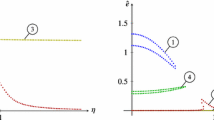
Overview
- Gives insight into the mechanism of vibrations and waves in order to control them in an optimal way Introduction to the systematic and intensive use of Hamilton's variational principle and its generalizations for deriving the governing equations of conservative and dissipative mechanical systems
- Presents the first principles from which the governing equations can be derived, and the adequate mathematical methods for their solving
- Presents the direct variational-asymptotic analysis and how many well-known methods in dynamics like those of Lindstedt-Poincare, Bogoliubov-Mitropolsky, Kolmogorov-Arnold-Moser (KAM), and Witham can be derived from it
- The new extended and reworked second edition of this successful book includes solutions to all exercises showing the energy and variational asymptotic method in “action”
- The present second edition also includes a new chapter on the new developments in slope and amplitude modulation of nonlinear waves
Part of the book series: Interaction of Mechanics and Mathematics (IMM)
Buy print copy
About this book
Energy Methods in Dynamics is a textbook based on the lectures given by the first author at Ruhr University Bochum, Germany. Its aim is to help students acquire both a good grasp of the first principles from which the governing equations can be derived, and the adequate mathematical methods for their solving. Its distinctive features, as seen from the title, lie in the systematic and intensive use of Hamilton's variational principle and its generalizations for deriving the governing equations of conservative and dissipative mechanical systems, and also in providing the direct variational-asymptotic analysis, whenever available, of the energy and dissipation for the solution of these equations. It demonstrates that many well-known methods in dynamics like those of Lindstedt-Poincare, Bogoliubov-Mitropolsky, Kolmogorov-Arnold-Moser (KAM), Wentzel–Kramers–Brillouin (WKB), and Whitham are derivable from this variational-asymptotic analysis.
This second edition includes the solutions to all exercises as well as some new materials concerning amplitude and slope modulations of nonlinear dispersive waves.
Similar content being viewed by others
Keywords
Table of contents (8 chapters)
-
Front Matter
-
Linear theory
-
Front Matter
-
-
Nonlinear theory
-
Front Matter
-
-
Back Matter
Reviews
From the book reviews:
“This textbook is addressed to teachers and students of mechanical and civil engineering. … To help the reader to become more proficient, each chapter ends with exercises some of which can be solved effectively by using Mathematica. … The main goal of this textbook is to help readers to acquire both a good grasp of the first principles from which the igoverning equations can be derived, and the adequate mathematical methods for their solving.” (Vasile Marinca, zbMATH, Vol. 1303, 2015)Authors and Affiliations
Bibliographic Information
Book Title: Energy Methods in Dynamics
Authors: Khanh Chau Le, Lu Trong Khiem Nguyen
Series Title: Interaction of Mechanics and Mathematics
DOI: https://doi.org/10.1007/978-3-319-05419-3
Publisher: Springer Cham
eBook Packages: Engineering, Engineering (R0)
Copyright Information: Springer International Publishing Switzerland 2014
Softcover ISBN: 978-3-319-05418-6Published: 18 March 2014
eBook ISBN: 978-3-319-05419-3Published: 08 July 2014
Series ISSN: 1860-6245
Series E-ISSN: 1860-6253
Edition Number: 2
Number of Pages: XII, 413
Number of Illustrations: 183 b/w illustrations
Topics: Vibration, Dynamical Systems, Control, Systems Theory, Control, Energy, general



